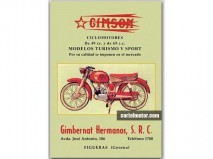1959 Gimson Sport 65cc
Exhibit: Joan Cabano
Gimson was a Catalan bicycles brand, manufactured by a company called Gimbernat Hermanos, S.R.C. located in Figueres, which also produced Mopeds and Velomotors during two periods: the first one in 1930 (producing a total amount of six), the second one from 1955 to 1982.
Gimson was an acronym for Gimbernat and Sons, the name that included Pierre Gimbernat and his three children: Pierre, Antoine and Françoise. Few years later they changed the business name for Gimbernat Hermanos, SRC. The company was always a family business. The main tasks where distributed to the three children of the founder: Pierre Gimbernat i Font, the eldest brother, was the chief Engineer, Antoine was at the production department and Françoise was in the office, at the sales department.
The company achieved a big commercial success and ended up having more than a hundred employees. Its main market was a part of Catalonia, the north-east of Spain. The Gimbernats came up with the second brand for their bicycles named Esbelta, meaning slim, able to have two distributors in the same place and have a better control of the market. At one point, Gimson won a contest to provide bicycles to the Spanish Civil Guard, before the unit was equipped with Sanglas motorcycles. These bicycles were used to patrol the countryside. They were standard models, even though they had a special support to place the rifles.
From 1955, Gimson returned to the motorcycle business, starting by mounting Cucciolo and Villiers engines. Later, they produced their own model with a Gamo engine -manufactured in Barcelona between 1950 and 1955- consisting of 49 cc (moped) and 65 cc (velomotor), very advanced for that time, two-speed, with a secondary transmission change and rear brakes on a mono-tube chassis on which the fuel tank of a bubble type protruded. The two versions of this model were named respectively 49 and 65.
Subsequently the model Sport was launched, that coexisted with the previous Turismo model, with the same engine and cylinder capacity. The Sport model was the first which had a T-shape stamped plate chassis that would become characteristic of the brand, with seat upholstery in two colors and a rounded fuel tank, as well as a painted exhaust pipe, unlike the general trend which was chromed. This model was distributed in color schemes of blue and gray or red and cream. Both models had a luxury option called Lujo, externally differentiated because the swingarm was tubular instead of stamped sheet metal, also had a different logo.








